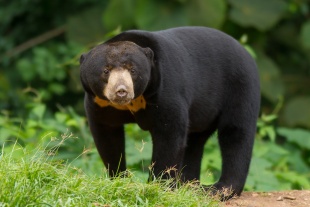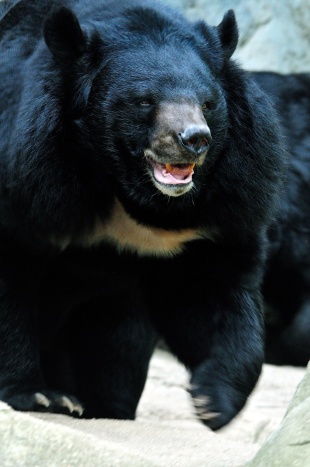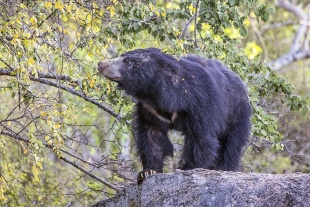BEAR SPECIES IN ASIA
Southeast Asia and East Asia are home to five bear species on the family Ursidae: 1) sloth bears of the Indian subcontinent; 2) sun bears (also known as Malayan bears) of southern Asia; 3) Asiatic black bears (moon bears) bears of Asia; 4) Giant Pandas of China; and 5) brown bears of North America, Asia and Europe (Grizzlies and Kodiak bears are kinds of brown bears);. Whether or not pandas are bears is a matter of debate but these days most scientists do regard them as bears. Red pandas are not classified as Ursidae. There are brown bears in the Himalayas, northern China, Mongolia, Japan and Russia. [Sources: Wikipedia, “Bears of the World “ by Terry Domico and Mark Newman (Facts on File, 1988) and articles from National Geographic, Smithsonian magazine and the New York Times]
There are eight species of bears worldwide The other three are: 1) polar bears of the Arctic (which evolved from brown bears a couple million years ago; 2) black bears of North America; and 3) Spectacled bears of South America; Relatively little is known about some of the bear species and subspecies in Asia and South America.
Websites and Resources on Animals: Bear Conservation bearconservation.org ; Bear Book and Curriculum Guide web.archive.org ; Animal Diversity Web animaldiversity.org ; BBC Earth bbcearth.com; A-Z-Animals.com a-z-animals.com; Live Science Animals livescience.com; Animal Info animalinfo.org ; World Wildlife Fund (WWF) worldwildlife.org the world’s largest independent conservation body; National Geographic National Geographic ; Endangered Animals (IUCN Red List of Threatened Species) iucnredlist.org
RELATED ARTICLES:
BEARS: HISTORY, EVOLUTION, HABITAT, HUMANS, PIZZLIES factsanddetails.com
BEAR CHARACTERISTICS: PHYSIOLOGY, DIET, LIFESPAN factsanddetails.com
BEAR HIBERNATION, REPRODUCTION, CUBS factsanddetails.com
BEAR BEHAVIOR: TERRITORIALITY, HABITUATED TO HUMANS, OPENING CARS factsanddetails.com
BEARS: BILE, BODY PARTS, CHINESE MEDICINE AND FOOD DELICACIES factsanddetails.com
Sun Bears
Sun Bears (Helarctos malayanus) are also known as honey bears and Malayan sun bears. They are the only truly tropical bear in Asia. Relatively small and elusive, they are found primarily in the lowland tropical rainforests in Southeast Asia, northeast India, Bangladesh, southern China and the islands of Sumatra and Borneo. The largest population of them is thought to be in Borneo. The bears are named after the reddish “sun” patch on their chest that varies in shape from a U-shape to a circle to an irregularly-shaped spot — and sometimes is not present at all. Sun bears are stocky and have have doglike body. This and their small size have earned it the local name dog bear.
Adult sun bears have few predators except humans, due to their fierceness and formidable teeth. Occasionally, they may be overwhelmed by a tiger or large reticulated python. Other possible predators include leopards, clouded leopards, and the sun bear's larger relative, the Asiatic black bear. The sun bear's loose skin on its neck allows it to wriggle its body inside its skin fast enough to turn around and bite its attacker when grabbed. It addition to biting it can rip at attackers with its sharp claws. Some locals say a sun bear is the most dangerous animal a person can encounter in the forest and even tigers keep their distance. There have been reports of unprovoked attacks on other animals, with the sun bear barking as it attacks.
Sun bears are very hard to find in the wild and precious little is known. The recent decline in the sun bear population can be largely attributed to the hunting of "nuisance bears" that destroy crops and widespread poaching driven by the market for their fur and for their bile, which is used in Chinese medicine. Sometimes mothers are shot by poachers for their body parts and the cubs are sold as pets. Because it spends so much time in trees, the sun bear can sometimes cause damage to property. It has been known to destroy coconut palms and cacao trees on plantations. They like palm hearts — whose removal can kill a tree — and sometimes return to the same place on successive nights, inflicting heavy damage. The biggest threat to the sun bear is habitat destruction as a result of deforestation caused by slash-and-burn agriculture, logging and rubber and palm oil plantation development.
Sometimes, sun bears are captured or bred to be domestic pets — a role for which they are considered desirable, due to their relatively inoffensive nature and small size in comparison with other bears. Cubs are very playful and adorable. Poachers in Borneo use logging roads to gain access remote tracts of forest and scan the forest with searchlights — an illegal technique in the U.S. called “jacklighting” — to locate bears and other animals by the bright glow of their eyes and stun them long enough to blast them out of the trees with a shotgun. The IUCN classified the sun bear as "vulnerable" in 2007.
See Separate Article: SUN BEARS: CHARACTERISTICS, BEHAVIOR AND REPRODUCTION factsanddetails.com
Asiatic Black Bears
Asiatic black bears are sometimes called moons bears after the crescent shape white mark on the otherwise black bear has on its neck. This animal is widely distributed throughout the mountains and forests of Asia from Iran and Pakistan in the west to Japan in the east and Russia to the north and the Himalayan foothills to south. Further south in the rain forests of Southeast Asia the sun bear makes its home. Moon bears are relatively plentiful in some places but overall are threatened by overhunting and loss of habitat. There are an adaptable species found in coastal and at elevations of over 4000 meters. Between 16,000 and 25,000 of them live in high-altitude forests in Asia. They are a protected species.
Asiatic black bear’s scientific name Selanarctos thibetanus literally means “moon bear of Tibet.” Also called the Tibetan black bear or Himalayan black bear, the animal is morphologically very similar to some prehistoric bears, and regarded by some scientists as the ancestor of all other existing bear species. Though largely herbivorous, Asian black bears can be very aggressive toward humans, and have frequently attacked people without provocation. The species was described by Rudyard Kipling as "the most bizarre of the ursine species."
Scientists have proposed that Asian black bears are a surviving, slightly-modified form of Ursus minimus, an extinct species that arose four million years ago. With the exception of the age of the bones, it is often difficult to distinguish the remains of Ursus minimus with those of modern Asian black bears. Asian black bears are close relatives to American black bears, with which they share a European common ancestor; the two species are thought to have diverged 3 million years ago, though genetic evidence is inconclusive. The earliest American black bear fossils greatly resemble the Asiatic species. One DNA study could not statistically resolve the branching order of sloth bears and the two black species, suggesting that sloth bears, moon bears and American black bears underwent a rapid radiation event.
See Separate Article: ASIATIC BLACK BEARS (MOON BEARS): CHARACTERISTICS, BEHAVIOR factsanddetails.com
Sloth Bears
The sloth bear is a small- to medium-size bear found in the lowland forests of India, Nepal, Sri Lanka, Bhutan and Bangladesh. Able to thrive in a variety of habits, including thorn scrub, grasslands and dense forests, as long a sufficient food supply is available, these animals are unique among bear species in that they feed primarily on ants and termites like and anteater and females carry their young on their back. [Source: Adele Conover, Smithsonian; John Eliot, National Geographic, November 2004]
It is estimated that between 10,000 and 25,000 sloth bears remain, primarily in enclaves scattered across India, where between 6,000 and 11,000 of them live . Their numbers have been reduced by poaching and habitat loss. In the old days they were hunted out of many areas. Now they survive mostly in isolated enclaves. In some part of India cubs are abducted for the dancing bear trade. Sloth bears many of the same areas as tigers and conservation efforts to help tigers have also helped sloth bears.
The first reports of sloth bears by European hunters in India described their trunklike snouts, their habit of hanging from tree limbs and their baby-like cries. John Eliot wrote in National Geographic, “ Scientific blunders can live on forever. When 18th-century European museum curators were first sent specimens of a large furry mammal with long curved white claws, they named it "bear-like sloth" because its claws resemble those of South American sloths. Later taxonomists realized that the species was a tropical bear unrelated to sloths, but its wrongheaded name remains — the sloth bear. They sound like bellows when using their flexible snouts and lips to blow away dirt and suck up termites and ants. But don't be misled: This frowsy, gentle-looking bear can be ferocious, occasionally mauling or killing villagers who enter the forest. Yoganand often talks with villagers to help minimize conflicts. "Attacks can be prevented if people avoid certain places."
See Separate Article: SLOTH BEARS: CHARACTERISTICS, BEHAVIOR AND REPRODUCTION factsanddetails.com ; SLOTH BEARS AND HUMANS: DANCING, QALANDERS AND ATTACKS factsanddetails.com
Brown Bears
Japan Brown bear Brown bears rank with polar bears and Siberian tigers as the world's largest land carnivores. The largest known brown bears weigh around 850 kilograms (1,800 pounds) and stand also four meters (12 feet) tall on their hind legs.
Brown bears have been around millions of years, sharing Siberia, Eurasia and North America with mammoths, mastodons, giant beavers and saber tooth tigers. Polar bears evolved from brown bears. The two species are similar enough that today they have breed in zoos and produced fertile offspring.
There are around 70,000 brown bears and grizzly bears in North America. There are also large numbers of them in Russia and they are found elsewhere in northern Asia and Europe. For some reason there are lot of them in Romania. The rare Tibetan bear is among the brown bear subspecies.
See Separate Article: BROWN BEARS factsanddetails.com
Giant Pandas
Giant pandas are among the world's best loved animals. They are fixtures of animal stories for children, an inspiration for toys, objects of diplomacy and propaganda and the symbol of the World Wildlife Fund. They used to roam much of China. Now, they are found only in a few small enclaves. About 1,600 giant pandas live in the wild, and an additional 190 or so (2005) live in captivity in China and zoos around the world.
In China pandas are known as “da xiongmao” (“big bear cats”). Their scientific name is “Ailuropoda melanoleuca” (“black and white car-footed bear”). For a long time it was thought that racoons, red pandas and giant pandas belonged to the same family in part because red pandas and giant pandas share the same name and both eat bamboo and red pandas and racoons look kind of similar. Recent analysis based on genetics and molecular biology techniques have determined that giant pandas are indeed a member of the bear family while red pandas are so different from bears and racoons they should be put in their own unique groups.
In a definitive study “The Giant Panda: A Morphological Study of Evolutionary Mechanisms” by D. Dwight Davis concluded: “Every morphological feature examined indicates that the giant panda is nothing more than a high specialized bear.” Pandas differ from other bears in they don’t move around much; their range is smaller; and they are almost purely vegetarian.
RELATED ARTICLES:
GIANT PANDAS: THEIR HISTORY, HABITAT AND CHARACTERISTICS factsanddetails.com ;
PANDA BEHAVIOR AND EATING HABITS factsanddetails.com ;
PANDA REPRODUCTION AND CUB RAISING factsanddetails.com ;
ENDANGERED PANDAS: LOSS OF HABITAT AND EFFORTS TO SAVE THEM factsanddetails.com ;
PANDA CAPTIVE BREEDING factsanddetails.com ;
PANDA REWILDING factsanddetails.com
PANDAS AND HUMANS: ANCIENT CHINA, ATTACKS, FANS, NATIONALISTS factsanddetails.com
RED PANDAS factsanddetails.com
PANDAS IN SICHUAN: WOLONG RESERVE AND CHENGDU RESEARCH BASE factsanddetails.com

1) Giant Panda (Ailuropoda melanoleuca), 2) Andean Bear (Tremarctos ornatus), 3) Sun Bear (Helarctos malayanus), 4) Sloth Bear (Melursus ursinus), 5) Asiatic Black Bear (Ursus thibetanus), 6) American Black Bear (Ursus americanus)
Image Sources: Wikimedia Commons
Text Sources: Animal Diversity Web animaldiversity.org ; National Geographic, Live Science, Natural History magazine, David Attenborough books, New York Times, Washington Post, Los Angeles Times, Smithsonian magazine, Discover magazine, The New Yorker, Time, BBC, CNN, Reuters, Associated Press, AFP, Lonely Planet Guides, Wikipedia, The Guardian, Top Secret Animal Attack Files website and various books and other publications.
Last updated January 2025




